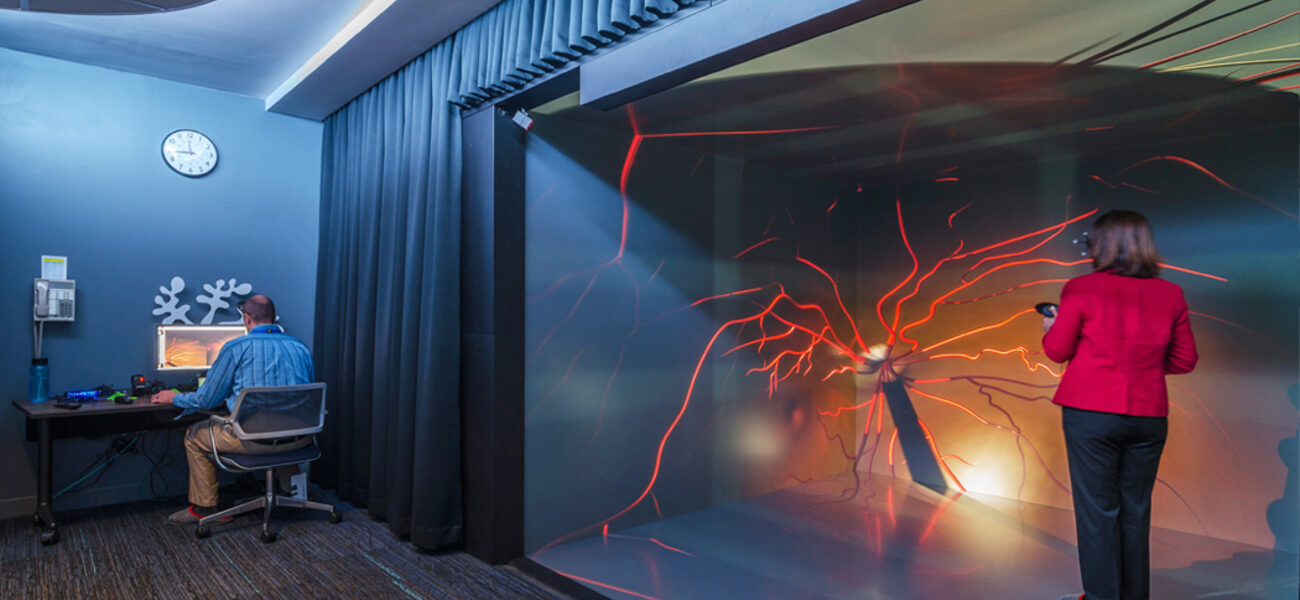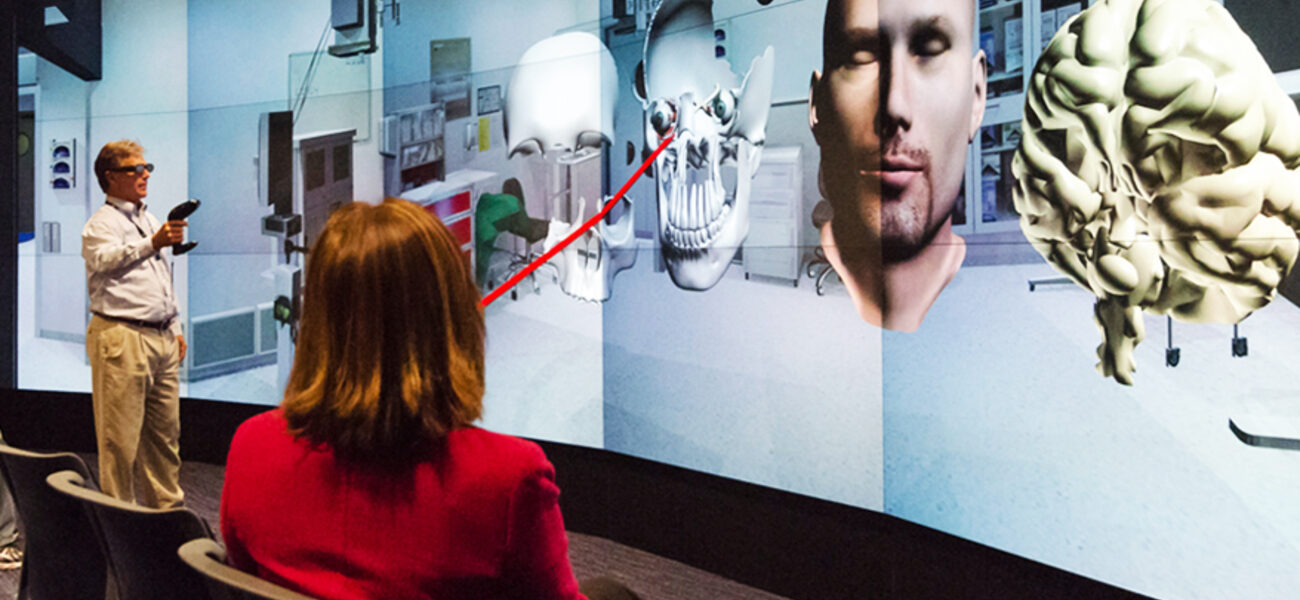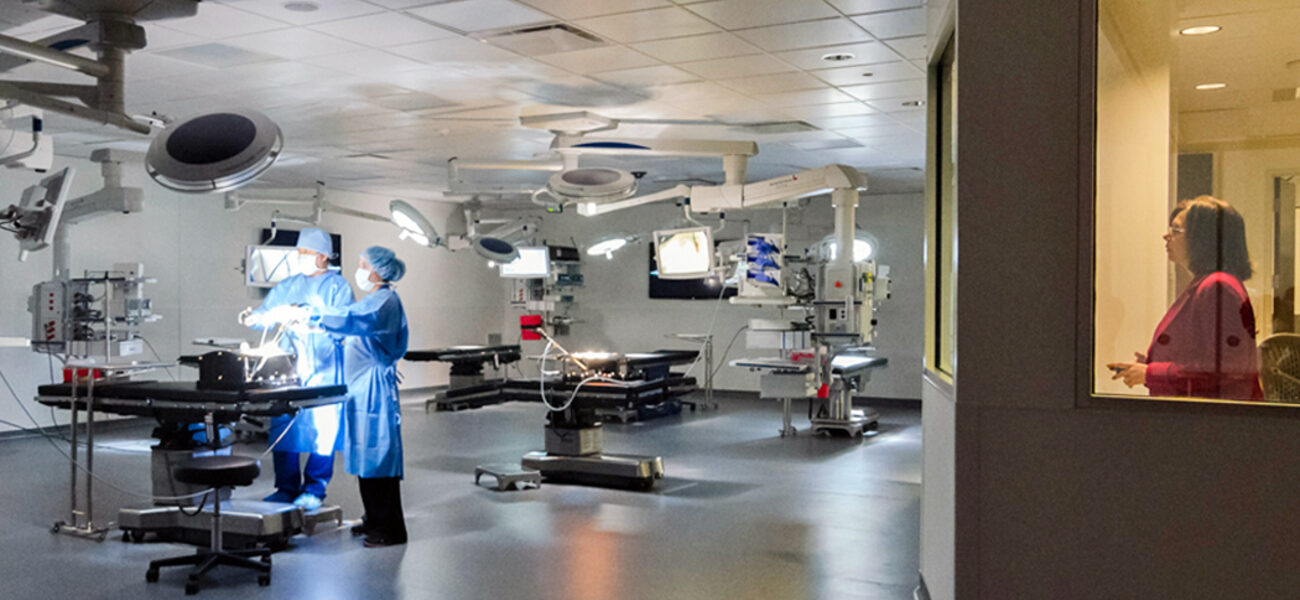The University of Toledo’s Interprofessional Immersive Simulation Center (UT-IISC) represents a new technology-driven approach to educating tomorrow’s healthcare professionals. Utilizing state-of-the-art virtual reality environments, the UT-IISC provides interactive and experiential environments for training, education, and research. Giving students, researchers, and clinicians the unprecedented ability to “fly through” organs of the body and visualize them in highly detailed digital 3-D, the center was developed to improve patient safety as well as efficiencies in healthcare.
The four-story, 65,000-sf facility is designed around a unique “tri-center concept” for medical instruction that features a virtual immersive reality center, an advanced clinical simulation center, and a progressive anatomy and surgical skills center, designed to create a naturally integrated learning progression that emphasizes teamwork. The new facility also includes a strikingly futuristic sky-lit atrium, several interactive 3-D CAD walls—including a large curved CAD wall identical to the one at Oakridge National Labs in Tennessee—and the world’s first five-sided, seamless stereoscopic LED virtual immersive environment.
“The facility has a wide range of simulation labs and the broadest possible range of simulation and visualization technology,” says Pamela Boyers, executive director of the UT-IISC. “Additionally, the UT-IISC is highly integrated. Communication can occur room to room, floor to floor, as well as internally to externally.”
These simulation labs are designed to teach communication, procedural skills, decision-making, and teamwork across all healthcare disciplines, including medicine, nursing, orthopedics, and physician assistants.
The 3-D virtual immersive reality environments that attract the most attention are on the first floor. The advanced clinical simulation center on the second floor houses a wide range of healthcare settings, including homecare, a doctor’s office, a pediatric unit, and an “elliptical hospital” complete with ICU, trauma suite, OB delivery suite, and operating room—all equipped with human patient simulators.
“It’s a very comprehensive center where modeling, simulation, gaming, and visualization converge to create the optimal learning environment,” says Boyers. “We’ve found that the modern learner really takes to it.”
The interconnected design means that, for example, students can fly through a healthy lung, comparing it to a lung with chronic obstructive pulmonary disease. Then move to the advanced clinical simulation center to practice taking care of a patient experiencing an asthmatic attack. They can then work their way to the surgical skills center where they learn and practice lung-related surgical procedures.
“This flow can be varied according to the procedure or scenario being taught,” says Boyers. “It also works well for conducting R&D tests in collaboration with companies doing new product development.”
Future is Now
Designed specifically for the UT-IISC by Barco, the I-Space is the world’s first five-sided, seamless stereoscopic LED virtual room for medical education and research.
“Barco shared in the cost of research and development of the I-Space with the understanding that we would introduce this technology in a field where it had not been previously applied,” says Boyers.
The two-ton glass floor of the I-Space was shipped from Germany and carefully installed before the building’s exterior walls were erected. Providing a fully immersive environment that utilizes tracking capabilities and stereoscopic glasses, it projects detail-rich visuals at twice the rate of HDTV. The images are processed by 18 computers powering 34 synchronized projection engines that maintain color and brightness consistency across the array of energy-efficient LED panels.
“With the I-Space, we can create any environment we want for any discipline,” says Boyers. “It could be underwater scenarios, oilrig or military environments, or even outer space. For medicine, we use it to explore the human body, specific organs, or view real patient data in 3-D.”
The I-Space, curved CAD wall, and flat CAD walls each provide different levels of visualization. While the I-Space is a fully immersive environment for as many as four people, the curved CAD wall provides a 180-degree viewing experience for larger group interactions (as many as 30 people). The flat CAD walls, located in two smaller rooms, are for smaller groups and more focused learning. The center was also designed so that all UT colleges, including Engineering, Business, Natural Sciences and Arts could benefit from the advanced technologies.
Real Patients, Real Data
In addition to being able to virtually fly through a heart to visualize valves, atria, and ventricles, students and researchers can also convert real patient CAT and MRI data into 3-D volumetric renderings that are capable of 360-degree rotation and active sectioning in axial, coronal, and sagittal planes.
“Faculty and students were beginning to put together teaching modules where they could fly through the human body,” says Boyers. “Then we started to wonder if we could bring real patient data into these environments, which we have been able to do to a limited extent.”
The ability to move real CAT scan and MRI images into the facility’s 3-D environment means the technology also has tremendous clinical potential.
“Some of our clinicians are considering using the spaces for preclinical planning,” says Boyers. “For example, they could bring in a CAT scan of a patient so they can fly into the lung and see the patient’s actual pulmonary embolus from the inside in order to measure and understand it better. We are really right at the front of this journey.”
ROI – Quantitative vs. Qualitative
The $34 million facility, which opened April 2014, was built on a joint academic and business model. To help achieve ROI more rapidly, the doors are open to collaboration. Eventually, much of the revenue required to help keep the center up to date will come from research and development projects conducted by industry partners in a variety of fields. Other academic organizations will also utilize the facilities to do training and surgical workshops. Currently, the center serves between 1,800 and 2,000 learners a month.
“While tracking the quantitative ROI is important, there is also the significant but more difficult-to-measure element of qualitative ROI,” says Boyers. “It is important we find ways to clearly articulate the qualitative elements of the ROI in a project like this because they really matter. We have yet to learn how to turn qualitative feedback into metrics, but we do know about learner satisfaction with the simulation experiences. And based on the sheer numbers of visitors that come to the IISC from all over the world, we know that the center is having a positive impact on the University of Toledo’s reputation.”
According to Boyers, one of the major challenges facing healthcare education today is that students still learn in silos within their disciplines and, for the most part, only come together as a team for the first time at the bedside of a patient.
“Advancing interprofessional education and collaboration is an absolute challenge for healthcare education,” she says. “The real question is how do you teach healthcare professionals in busy, highly technical clinical settings while also improving patient safety and helping avoid medical errors? Having safe but realistic simulated environments helps address this critical issue.”
Culture of Collaboration
A large reason for the success of the UT-IISC is the strong focus on interprofessional collaboration.
“The UT-IISC was truly a collaborative process right from the beginning,” says Boyers. “It started about six years ago, when the deans and faculty of the colleges of nursing, medicine, health sciences, and pharmacy, under the leadership of the university, got together with our facility planners to ask how we can create an ideal learning environment that is conducive to training the modern healthcare professional.”
Planning the UT–IISC involved deans from engineering and natural sciences. Healthcare professionals at the University of Toledo Medical Center were also consulted to determine what quality and safety issues they were encountering.
“From the safety perspective, one of the first requests from the hospital was for help with teaching the correct use of advanced technology, such as bronchoscopes,” says Boyers. “Currently all staff and students are taught how to use a bronchoscope in the IISC and are assessed for competence. Our ultimate goal is to have every medical procedure taught using a similar model.”
After aligning course requirements with the curriculum committees, UT now has a combined interprofessional education course that is required for all first-year healthcare students. This course utilizes the IISC to provide interactive, hands-on patient care experiences.
“A key to the success of this project has been the incredible level of collaboration with the professionals who helped envision the center, the architects and engineers who helped design and build the center, and our industry partners,” says Boyers.
By Johnathon Allen
This report is based on a presentation by Pamela Boyers and Charles Lehnert, University of Toledo’s vice president of corporate relations, at Tradeline’s Facilities for Academic Medical and Allied Health 2014 conference.





